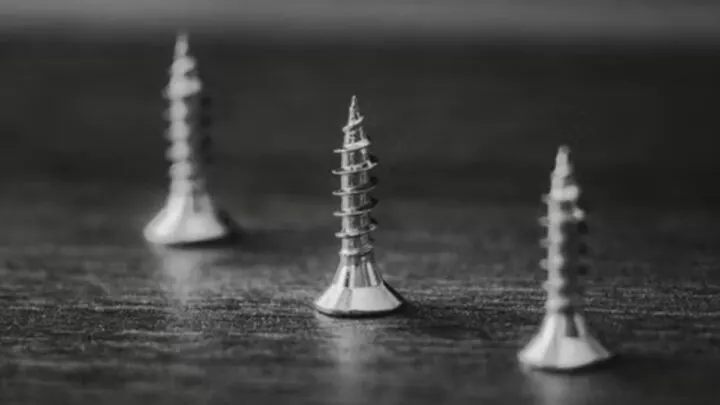Hammering in a screw to hang something up can be tricky, especially since you have to get it right the first time or potentially ruin your wall.
You can hammer in a screw as long as you use the correct technique. However, hammering in a screw can be tricky, since it could damage the rings of the screw and potentially damage your wall as well.
For that not to happen, it is advised to use a longer screw.
Other factors to consider are that when hammering in a screw, you might make a hole too large for the screw itself, leaving it loose in the wall, which is dangerous if you plan on hanging something up.
We have put the question to many woodworkers and handymen, who have given us some great answers and tips on getting it right the first time.
Hammering in a Screw
Whether you’ve ever needed to do some DIY but don’t have a screwdriver or drill, you might be wondering if you can just use a hammer instead.
So, what’s the deal? Are you able to easily pound a screw in?
It is possible to hammer in screws using the proper technique. However, it is not encouraged since the screw and the surface it’s going into may be damaged.
Hammering a screw can create a wide hole in the thread, causing the screw to fall out or not be secure enough to carry any weight.
Let’s look at how to do it correctly, as well as when it’s the ideal option.
Yes, you may use a hammer to drive a screw into a wall. The screw’s threads, on the other hand, are likely to rip a hole large enough for the screw to simply pop back out!
Even if it does stay in place, it might not be secure enough to hold any weight. It’s better to start by hammering in a smaller nail compared to a screw, then removing the nail and replacing it with the screw.
However, whenever possible, it is advised to use the proper instrument, such as a screwdriver or a power drill instead.
How Do You Hammer In a Screw?
When you hammer a screw, you almost always wind up stripping it and the hole. It’s the same thing that happens if you make a screw too tight or when you don’t tighten it enough in the first place.
You can efficiently drive a screw into a piece of wood with a large enough hammer (and lots of power).
Just make sure you don’t destroy your wall (or worse, injure yourself) in the process!
It’s also worth noting that pounding a screw in would certainly shatter it. They aren’t meant to be pounded in the same way that a nail is.
A screw’s shearing strength isn’t as high as a nail’s. A screw has a significantly better gripping strength due to its threads.
That said, it all depends on why you are hammering in a screw in the first place. For instance, if you don’t have the necessary equipment to make a hole in the wall for a wall plug, you can use a screw instead.
You may accomplish this by pounding the screw in place and moving it around with pliers to widen the hole.
This allows you to insert the wall plug into the hole you’ve just created and secure it with the screw.
If you can’t get a screw to “go in” using a screwdriver or power tool, try pounding or tapping it into the wall.
However, you must use caution when doing so, as you risk damaging your wall.
You can wind up putting a wider hole in the wall than is necessary, causing the drywall to crumble.
The area will then need to be patched, sanded, and repainted. If at all possible, avoid this pricey and time-consuming remedy.
Remember that putting too much power on a screw might cause it to break, which is certainly something that you do not want to deal with.

Tips to Hammer in a Screw
Hammering in a screw may seem pretty straightforward, right? But, you will need to get it right the first time or else have to deal with a loosely hanging frame, or worse, a damaged wall.
Professionals recommend drilling a pilot hole beforehand to avoid damaging the material you’re screwing into and keeping the screw straight.
To produce a tiny hole, use a hammer and a small nail to create a pilot hole.
After you’ve formed the pilot hole, insert the end of the screw into the hole you’ve just created. The screw will be held in place by the pilot hole as it is hammered in.
To provide the screw enough stability, make a hole deep enough for it to remain in on its own for a short period of time.
It goes without saying that if you are using a long screw, you will need to make a deeper hole.
Choose a nail that is just a smidgeon smaller than the screw. Puncture a hole in the wall by pounding the nail exactly deep enough into the wall to create a hole.
Remove the nail from the wall and place the screw in its place. Hang your object on the screw gently and carefully. If the hole becomes too large, you might try to patch it up with some liquid glue.
If your hole becomes too large by mistake, you can patch it using liquid glue.
To achieve this, you’ll need some toothpicks, which you’ll insert into the hole you’ve just filled with glue and then snap or cut to the appropriate length so they don’t protrude from the wall.
You should now be able to put the screw back into the hole you just fixed and use the tips above to hammer in the screw.
Summing Up If You Can Hammer In a Screw
It’s definitely possible to hammer in a screw, but like most other DIY things, you have to be careful when doing so.
Hammering in a screw incorrectly can damage your wall, and if you’re not careful, you can also hurt yourself in the process.
Make sure you follow these tips to safely and successfully hammer in a screw!


